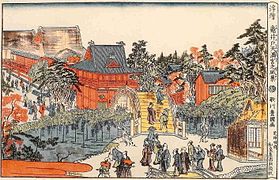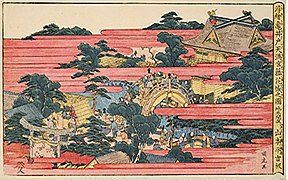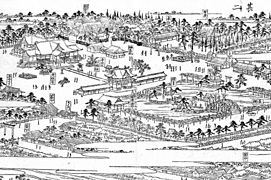Kameido shrine
The Kameido shrine ( Japanese 亀 戸 天神 社 , Kameido Tenjinsha ) in the Kōtō district in Tokyo is dedicated to Sugawara no Michizane , the protector of scholars.
History and meaning
Michizane (854–903), one of the great scholars of the Heian period , died during a kind of exile in Dazaifu and was worshiped there in a large-scale shrine. In the middle of the 17th century, the high priest of the Dazaifu shrine, Ōtorii Nobusuke, tried to build an appropriately large shrine next to the already existing Yushima Tenman-gū in the flourishing Edo . As part of the reconstruction after the great Meireki fire in 1657, in 1661 he was given an area next to a plum garden in Kameido on the eastern edge of the city, which went well with the plum blossom in the Sugawara coat of arms. Following the example of Dazaifu, a heart-shaped pond was created in front of the shrine, over which two drum bridges ( 太 鼓 橋 , Taiko -bashi ) were built. The outer, larger one is called the “men's bridge” ( 男 橋 , Otoko-bashi ), the inner, smaller “women's bridge” ( 女 橋 , Onna-bashi ). Trellises with wisteria were laid on the pond .
The court sponsored the shrine. Gomizunoo - tennō is said to have written the name tablet and Reigen -tennō poems about Tenman tenjin for the shrine. In 1777 Shogun Tokugawa Ietsuna visited the shrine. In 1873 the shrine was given the name Kameido-jinja ( 亀 戸als ) as a city shrine ( 府 社 , fusha ), and in 1878 the name Kameido tenjin-sha .
As a special feature of the north-south oriented shrine, the corners of the roof of the entrance gate were decorated with the Shijin ( 四 神 ). These are the four animals in characteristic colors that are assigned to the four cardinal points in Chinese mythology. This idea reached Japan as early as the 8th century, as evidenced by the painting of the Takamatsuzuka tomb ( 高 松 塚 古墳 , Takamatsuzuka kofun ) in Nara prefecture . The east is marked by the blue dragon ( Seiryū ), the south by the red bird ( Shujaku ). In the west stands the white tiger ( Byakko ), in the north the black turtle ( Genbu ).
The shrine burned down in World War II. During the reconstruction, the gatehouse in the Rōmon ( 楼門 ) style was omitted .
Every year on January 24th and 25th - similar to Dazaifu on January 7th - the usokae ritual ( う そ 替 え - 事 , usokae shinji ) is performed. This is a play on words with uso ( 鷽 ), a bird, and uso ( 嘘 ), the lie. By exchanging wooden Uso birds, one hopes that the lies of last year may turn into something good after all. Since Sugawara no Michizane is the helper in science, the shrine is often visited during the university entrance exams in January and February to put up a petition plaque ( Ema ) there. One week is celebrated in early summer when the Wisteria are in full bloom. The rice balls ( 葛 餅 , kuzumochi ) dusted with seasoning flour in the entrance area have been sold by the Funabashiya store since 1805.
The popular shrine soon became a popular destination and was often depicted. The best known is the sheet of Hiroshige with the large drum bridge, but there are other sheets of him that show more of the shrine complex. When it is depicted in winter, however, important details of the gatehouse are missing.
photos
Yoshida Hiroshi , 1927
Remarks
- ↑ After the name Tenman tenjin ( 天 満 天神 ) given to him posthumously , shrines after him are also called Tenmangū ( 天 満 宮 ). The shrine in Edo / Tokyo is also known as the Dazaifu Tenman-gū of the East .
- ↑ That was the garden with the plum trees that Vincent van Gogh painted after a print by Hiroshige .
- ↑ Shrines dedicated to Sugawara no Michizane always show the plum blossom coat of arms on the gable.
- ↑ The heart shape of ponds is created by the character for heart drawn in one go: 心 .
- ↑ Here, Hiroshige probably used imprecise templates for guidance, as he did occasionally, before he later went there himself and correctly drew the gatehouse.
literature
- Kameido Jinja. In: Encyclopedia Nipponica 2001. Shogakukan, Tokyo 1996. ISBN 4-09-526125-0 (Japanese).
- Cameido jinja. In: Tōkyō rekishi no sanpo - jō. Yamakawa, Tokyo 1988, ISBN 4-634-29130-4 .
Web links
Coordinates: 35 ° 42 ′ 10 ″ N , 139 ° 49 ′ 15 ″ E









